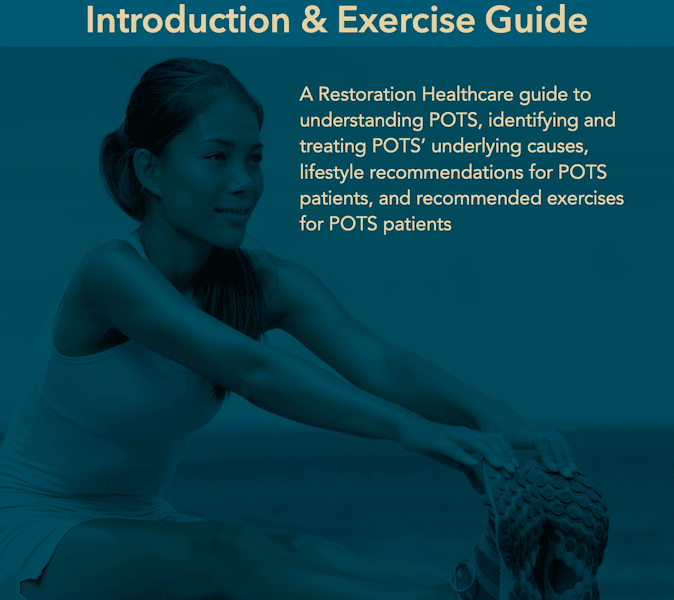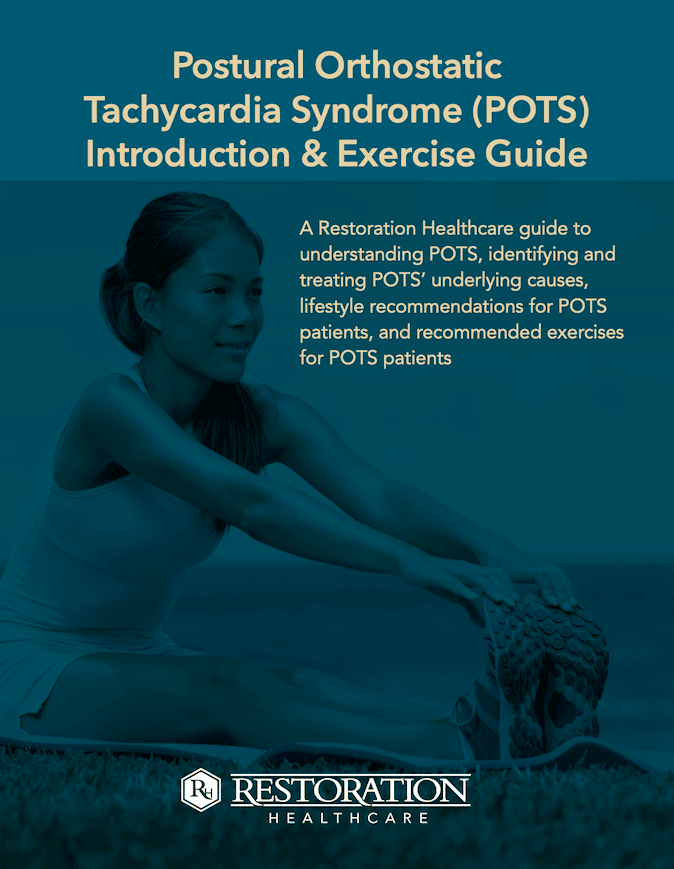Restoration Healthcare Offers Exercise Guide for POTS Sufferers

When you discover that you’re suffering from an ailment that makes you lightheaded, nauseous, exhausted, headachy, or anxious — or all five — the last thing you probably want to hear is that there’s an exercise regimen that can help relieve those symptoms.
But what we’re talking about are symptoms associated with Postural Orthostatic Tachycardia Syndrome, or POTS. For the uninitiated, POTS is a condition in which much of your blood stays in the lower part of your body when you stand up, thus prompting the headaches, faintness, and other associated symptoms. Within minutes after getting on your feet, your heart starts pounding as your body frantically tries to pump blood to your brain and upper body.
And it’s why we recently published the Restoration Healthcare Postural Orthostatic Tachycardia Syndrome (POTS) Introduction and Exercise Guide, which we’re making available here as a free download (right click on the image below to download the guide).
Since its publication, we have been recommending our POTS Guide to our patients diagnosed with Postural Orthostatic Tachycardia Syndrome, as well as any of our patients who might be struggling to make it over the hump of getting started on the path to fitness. That includes new and postpartum moms, patients recovering from Lyme disease or exposure to toxic mold, and so on.
Feeling Conflicted About Exercise?
Starting a fitness program can often make you feel conflicted — you know that you won’t start to feel stronger and more energetic without exercising, but you really don’t feel like exercising when you’re weak and exhausted. This is especially true when you have a chronic illness that has sapped your strength and energy. You can start to feel like Superman or Superwoman in the presence of kryptonite. But it’s worse for you — you can’t just step away from a chunk of kryptonite to restore your vitality.
The not-so-secret solution is to ease into a workout regimen gradually — crawl, walk, then run — as you feel comfortable doing so. This approach is ideal, especially for people living with POTS.
About Our Postural Orthostatic Tachycardia Syndrome (POTS) Introduction and Exercise Guide
Our guide begins with a brief introduction followed by a short section on what POTS is, including insights into risk factors, diagnosis, and treatment. Although the treatment protocol varies for each patient, it involves medical treatment along with self-treatment — diet and lifestyle modifications and exercise.
Most of the guide is devoted to the POTS exercise program we recommend — a training program designed to build strength and endurance gradually over the course of eight months, or even longer if you prefer.
This eight-month program provides all the guidance you need, including the following:
- Eight monthly training calendars (you can progress at your own pace or follow the calendars)
- Warmup and cool down routines
- Weight-bearing and resistance exercises to build strength
- Cardio exercises to build stamina
- Training modes for self-regulating the intensity of your cardio workouts
- Heartrate zones to motivate you without overdoing it
- Post-workout stretches to keep you limber and prevent injury
- Encouragement and motivation to make exercise a lifelong therapy
Over the course of eight months, the program gets progressively more challenging. Here’s the overall approach:
- Months 1–3: Exercise only lying down or seated; for example, using a recumbent bike or a rowing ergometer, swimming laps (starting with kicking laps with a kickboard), or using a seated stepper machine
- Month 4: You can transition to exercising in the upright position; for example, riding an upright exercise bike
- Month 5: Increase your upright training at your own pace; for example, using an elliptical (without arm motion for the first few weeks) or walking on a treadmill (without incline at first)
- Months 6–8: Continue to increase your upright training; for example, add arm motion to your elliptical or an incline to your treadmill. If neither of those worsens your symptoms, you can try jogging or stair stepping. (Jogging is optional, never required.) Week 6 also marks the introduction of high-intensity interval training for some patients.
Download Our POTS Introduction & Exercise Guide for Free
Whether you’re not exercising and want to, or you’re exercising sporadically and struggling to find your groove, or you’re just disappointed with your progress, our POTS Introduction and Exercise Guide (PDF file) may be just what you need to get back on the path to health and fitness.
What do you have to lose, except weakness and fatigue and maybe a little weight (if that’s an objective)? The POTS Exercise Guide download is free, and you have everything to gain — strength, energy, and getting back to everything that makes your life enjoyable, fun, and fulfilling!
Before getting started, check with your doctor to see if you’re healthy enough for exercise and that the approach in our guide is going to be complimentary to your plan of care.
——————
Disclaimer: The information in this blog post about exercise and Postural Orthostatic Tachycardia Syndrome is provided for general informational purposes only and may not reflect current medical thinking or practices. No information contained in this post should be construed as medical advice from the medical staff at Restoration Healthcare, Inc., nor is this post intended to be a substitute for medical counsel on any subject matter. No reader of this post should act or refrain from acting on the basis of any information included in, or accessible through, this post without seeking the appropriate medical advice on the particular facts and circumstances at issue from a licensed medical professional in the recipient’s state, country or other appropriate licensing jurisdiction.


